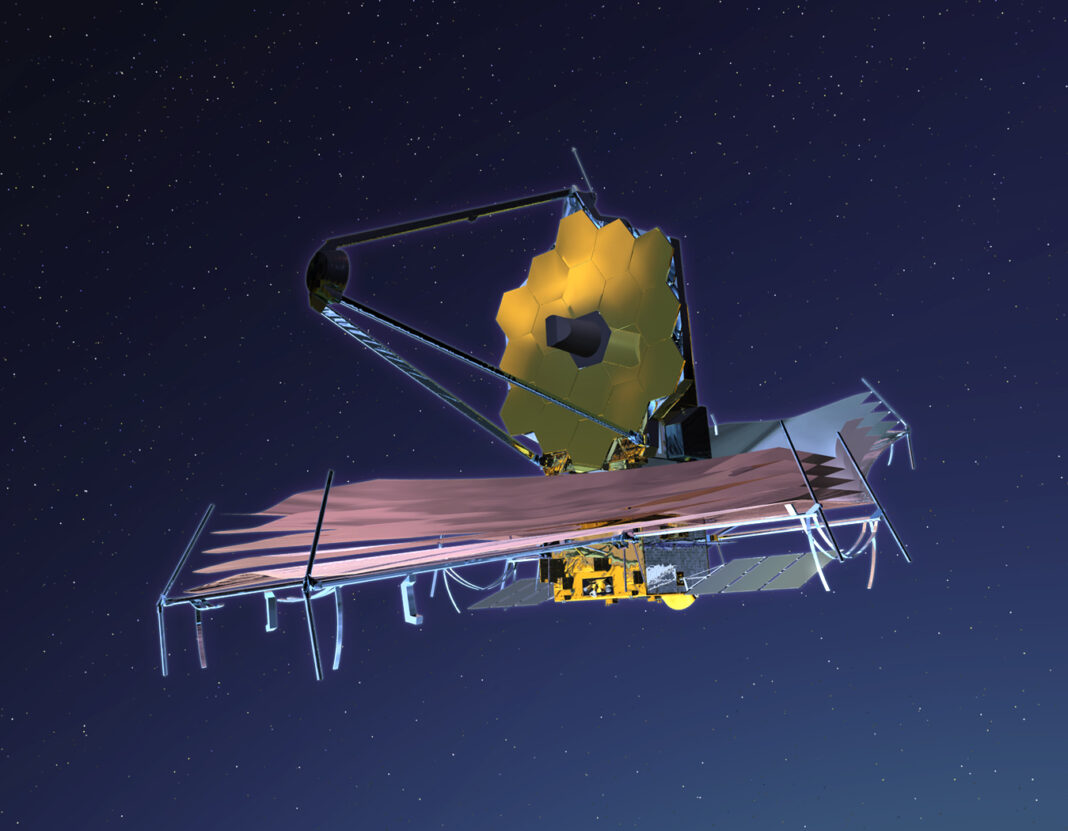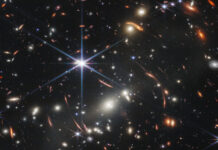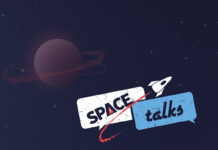“Nature speaks to men in a voice familiar to his soul”
Alexander von Humboldt
When Alexander von Humboldt sailed to Cumaná, Venezuela, he became obsessed with “scientifically” discovering the fabled river that links the Orinoco and the Amazon. He and Aimé Bonpland crossed from the lowlands to the rainforest—facing extreme heat, electric eels, and crocodiles—carrying the finest Prussian measurement instruments. As a careful observer and reporter of the cosmos of life, Humboldt demonstrated that the Amazon and Orinoco rivers are indeed connected.
Loaded with his spirit, astronomers are about to embark on a new adventure to learn more about the cosmos. Soon, the largest and most complex space telescope ever made, named after James Webb, will sail into space—as far as one and a half million kilometers away from the Earth—to boldly observe where no other telescope has observed before.
The journey of a multi-billion-dollar telescope
The James Webb space telescope odyssey started last month, when it departed from California on board the Colibri ship, crossed the Panama Canal, and arrived at Europe’s Spaceport in French Guiana for its launch this Christmas. But being thrown like a stone by a rocket into space won’t be the hardest part.
Due to its enormous size (only its main golden mirror being six and a half meters high), the Webb telescope will be launched origami folded. After crossing our moon’s orbit, like a butterfly emerging from its cocoon, it will delicately unfold itself until its protective shield and honeycomb mirror are fully deployed.
Every single step needs to proceed to perfection for the telescope to reach its final operational structure.
About a month after its launch, it will reach its orbit at a point called Lagrange 2, which is located in the line Sun-Earth-Moon. This place was chosen to protect the instruments, which need to stay in a very cold environment.
“For Webb in particular this is an attractive location because it is very stable and the telescope can stay at a relatively constant temperature. In L2 (Lagrange 2) it will always be shielded by the Earth from the Sun,” said Sarah Kendrew, one of the ESA-Webb scientists at the Space Telescope Science Institute in Baltimore, Maryland, USA.
Detecting heat of the universe with unprecedented sensitivity
The James Webb space telescope will observe in the infrared sector of the light, which means it will detect heat. For that reason, it is endowed with a multilayer shield that will help protect the instruments from any form of heat coming from the Earth-Moon system.
“It is particularly important because Webb is an infrared telescope. But all the objects here on Earth, around us, you and I, our houses, and everything radiates in the infrared; therefore, we need to suppress that radiation,” Sarah explained.
Between the main mirror and the multilayer shield, the space telescope will face a temperature difference of around 150 ºC.
“Due to the solar protectors, there will be a huge temperature difference, such that, on the warm side, you could boil an egg while, on the cold side, the mirror area, you could freeze oxygen,” illustrated Marcio Meléndez, one of the NASA-Astronomical Optics Scientists at the Space Telescope Science Institute in Baltimore, Maryland, USA.
Webb is the proud successor of Hubble. Besides their sizes and orbits, they have a crucial difference in that Webb will be able to observe—with an unprecedented sensitivity—in the near-infrared and mid-infrared light, while Hubble has been observing mainly in the visible part of the spectrum.
“Webb is so sensitive that it is capable of detecting the heat of a bee on the Moon,” said 2006 Nobel Laureate in Physics John C. Mather, and lead scientist of the project.
Because with the infrared light we can observe essentially the heat emanating from any object, such technology enables us to look into hidden, dark places like behind dense clouds of dust—precisely the regions where the stars are forming.
Another reason to use the infrared range is that the light coming from the early universe reaches us red-shifted due to the expansion of the fabric of space-time. Webb’s instruments will be able to catch that red-shifted light from the faintest, most distant, and fast-moving objects.
“The radiation coming from light interacting with hydrogen, the most abundant element in the universe, is visible and ultraviolet, but it reaches us red shifted due to the expansion of the universe. For these reasons Hubble is unable to see that light from the early universe, but Webb will have that power,” Marcio Meléndez explained.
Another advantage is that elements and molecules of life form unique patterns when interacting with infrared light. Therefore, with Webb, researchers will be able to look for that kind of chemistry, for example, in stellar clouds or the atmospheres of exoplanets.
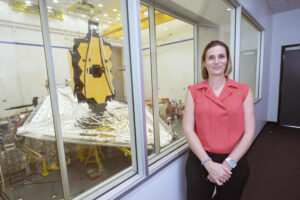
The James Webb space telescope is endowed with four state-of-the-art instruments: three will work in the near-infrared region (from 0.5 micrometers to 5 micrometers) and the fourth will cover in the mid-infrared, from 0.6 micrometers to 28.5 micrometers. Sarah Kendrew explained that the observations of these four instruments will complement each other, capturing the light of “lots of different pieces of the same puzzle.” She continued:
“We will be using them to look at the giant planets in the solar system, their moons, and also planets around other stars in our galaxy. It will really be able to characterize—in detail—what is happening in the atmospheres of those exoplanets and also look at other galaxies in the universe, from the ones that are very near to us to the very earliest galaxies that ever formed in the history of the universe.”
But what are the concrete questions scientists want to answer with this huge space observatory? Here, I will summarize the top five.
From our neighbouring planets to beyond the known frontier in the universe
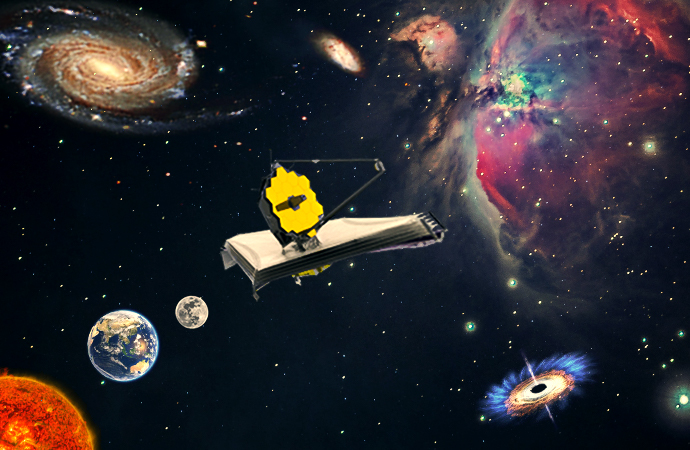
I. What did the early universe look like by the time the first stars lit up?
Compared with its predecessor, the Hubble telescope, which captured light from up to 12.5 billion years ago, Webb will observe up to 13.5 billion years ago—by the end of the Dark Ages of the Universe. The Dark Ages represents the epoch a few thousand years after the Big Bang, right after fundamental particles combined into simple atoms, mainly hydrogen and helium.

That period was supposed to be dark because the visible photons got trapped in the newborn atoms. By its end, clouds of hydrogen gravitationally collapsed, forming the first stars ever. The heavier elements were created in these stars, and these heavier elements are the material for the first rocky planets and life as we know it.
“One of the main scientific goals of the Webb is to observe the origin of the universe. How did the first stars and galaxies form 13.5 billion years ago? This is the moment when the first light emerged after the recombination era, when the universe was cold enough for the radiation to escape. How was this radiation? How is this nascent universe?” Marcio said.
Primitive stars are too faint to be detected by telescopes currently in operation, but here comes the James Webb: designed sensitive enough to witness the founding of the universe as we know it.
II. What was first, the “chicken or the egg”?
Well, biologists already know that the egg was first. But we still don’t know what was first: the supermassive black holes or the galaxies. How did these enormous galaxies with a supermassive back hole in their core come into existence? Were those first back holes formed and then, with its enormous gravity, attracted the rest of the mass around them to create galaxies? Or was it first that many stars got together, forming galaxies, and then after the collision of many stars, they merged into supermassive back holes in the galaxies’ center?
Recent studies from the ALMA observatory reveal that supermassive black holes may have ”co-evolved” together with their host galaxy. With Webb, astronomers will have the opportunity to observe the birth of the first supermassive black holes and the first galaxies. This way, they will be able to study how black holes’ evolution is linked to the formation of stars within galaxies.
“With Webb we expect to see how these very first galaxies formed. These very first galaxies were different, they did not have heavier elements. What type of stars were in them? We don’t know their sizes, and shapes and these are the most exciting aspects of the James Webb telescope because its science is so unique.” Sarah illustrated.
“We have two instruments: the NIRSpec [Near Infra-Red Spectrograph] and MIRI [Mid Infra-Red Instrument], which will catch the light spectrum of each pixel in the galaxies. In this way we will see the chemistry of each galaxy near the black hole and far from the black hole; we will be able to track the matter affected by the black hole. This is important because there is a moment when the black hole starts to emit a lot of radiation and, at that moment, the black hole might stop the galaxy’s growth and it may consume all matter contained in the galaxy,” explained Marcio Meléndez, who is involved in the supermassive black holes and galaxy formation research.
III. How do rocky, Earth-like planets get their water and molecules of life?
The space telescope infrared instruments will measure the molecular content of protoplanetary disk inner regions. These are the sectors that typically host rocky, Earth-like planets. Webb will specifically hunt for molecules that carry the common elements of life: carbon, oxygen, nitrogen, assessing the quantities of water, carbon monoxide, carbon dioxide, methane, ammonia, and any other observable organic molecule.
Webb will use the mid-infrared instrument to complement the far-infrared ALMA observation from Earth. The idea is not to localize the molecules in the planets but in the whole regions where they are forming. How? When light interacts with matter and is dispersed into its colors, it forms unique patterns that are fingerprints of elements and molecules. This allows scientists to identify not only what element or molecule is present but in which quantity.
“It can take images; it works like a camera. We have lots of different filters so that it will observe in many different colors of infrared light. We also have spectroscopy instruments onboard to disperse the light into its constituent wavelengths; and that is incredibly powerful because it lets us study the chemistry that’s happening in the observed objects: what kind of chemical elements are there, how they are interacting, how objects are moving, how galaxies are rotating, those kinds of questions,” explained Sarah Kendrew, who has been working for thirteen years in the science operations of the Mid InfraRed Instrument-MIRI.
Webb will also complement observations by NASA’s Spitzer Space Telescope—looking for water vapor in planetary disks around small stars—from brown dwarfs to Sun-like stars. The motivation is to help answer the big question: Where did our planet’s water come from?
IV. Where are other worlds with the chemistry to support life?
In 1992, scientists working at the Arecibo radio telescope announced the detection of two planets moving around a distant pulsar. It was the first of an avalanche of planetary systems discoveries. As of today, over four thousand exoplanets have been confirmed. Astronomers estimate that only in the Milky Way the number of exoplanets should be over a trillion.
But beyond cataloging rocks around stars, the driving conundrum is life in the universe. Are we alone? Experts handle many reasons why life—as we know it—should be out there, perhaps, not in one, but in many places. However, from the Earth, with the current instruments, it is not realistic to think of finding life on exoplanets, but habitable chemistry.
“We will be able to detect molecules in the atmospheres of exoplanets. There is a huge amount to learn in this area. We have only really started being able to do this with Hubble and some powerful ground-based telescopes. We are learning so quickly about exoplanets: how they look like, their properties, how they formed… It is going to be a very exciting area for Webb as well.”
“With Webb, there is a big focus on biosignatures, so people will look for molecules that may signal whether a planet may support life. There is a considerable amount of research that goes into that still. Even understanding what a biosignature would look like, the best molecules to look for,” continued Sarah Kendrew, who is also involved in the astrobiology Webb investigation.
One of the many ways astronomers use to detect exoplanets is the transit method. Consider, for example, the transit of Venus or Mercury in front of the Sun. When those planets pass between the Sun and us, they look like a dark spot crossing the Sun. Astronomers can also see the transit of exoplanets in front of their host star. However, with current technology, it is not possible to see an exoplanet spot but how the light from the host star diminishes.
“The way we observe these molecules [in exoplanets’ atmospheres] is that we observe the planet’s transit in front of its host stars. We observe the system when the planet passes behind the star. Then we observe the system as it passes in front of the star, and we look at the difference between those two data sets looking for small changes. But these are incredibly challenging observations; we are looking for signals that are not a few percent but a tiny, tiny fraction of a percent in the signal. So technically and scientifically, these are challenging observations. Still, Webb will be able to do exciting work in this area,” Sarah illustrated.
V. What is hidden under the surface of our neighbour giant planets and its moons?
Webb will peak through our giant neighbors’ moons’ atmospheres to map their weather, atmosphere components, and cloud structures. There are so many mysteries still to be revealed about those moons: How is the methane cycle on Titan? Does Ganymede have a hidden sea beneath its crusty icy water? Does Io really have volcanoes, as researchers suspect?
Uranus and Neptune will be the focus of the mission. We don’t know these far planets yet as well as we know Jupiter and Saturn. How is their chemistry? How are their moons, their rings? Webb will also investigate the dwarf planets and the asteroids, following up on NASA’s New Horizons mission. There is yet a lot to learn in that area, their mineralogy, and composition. Asteroids, in particular, are pristine rocky objects with plenty of information about the solar system’s origin.
What can go wrong?
Thirty years have passed since Hubble was sent into space and we still remember the trouble with a mirror and the multi-million-dollar special mission NASA needed to organize to install “corrective glasses” on Hubble.
According to Sarah Kendrew, in contrast to Hubble, Webb “has been designed very differently.” Unable to organize missions to travel that far away to repair anything, the engineers have included many backup systems. “There is a huge amount of coping with the risk that was included in Webb’s design.”
“The Webb telescope is really a big robot; it has at least fifty deployable mechanisms with three hundred and forty-four unique failure points. That means that if one of those points fails, the mission ceases to exist. These are thirteen more unique failure points than the last [NASA] mission to Mars. Another difference with Hubble is that Webb has eighteen moving mirrors while Hubble has only one mirror. This led us to ensure that if an optic problem arises, like happened to Hubble, we will be able to control and adjust, from the Earth, those eighteen mirrors, to obtain the quality images we want,” Marcio explained.
Unlike Hubble, Webb has already passed several tests on Earth under temperature and vacuum conditions resembling the environment it will face in space.
The launch, the people, the excitement
The James Webb space telescope collaboration of scientists is as huge as the mission. The partners include the European Space Agency-ESA, the Canadian Space agency-CSA, and the National Aeronautic Space Administration-NASA. The complete list of contributors surpasses the three hundred partners.
“It always blows my mind how large the project is, how many people are involved and have been involved for decades that we have been working on Webb. There are a huge number of partners, institutes, and companies, all involved in the same project. And one of the reasons is because it’s been a difficult, complex, mission.” Sarah expressed enthusiastically.
The universe is full of surprises. Beyond the excitement about the mission objectives—the uncertainty, the unknown that awaits us deep in space—is really the most exciting part of the James Webb space telescope mission. The same mystery for the unknown that dragged Alexander von Humbold to explore deep in the jungle. Marcio communicated his excitement on the subject:
“Beyond the scientific questions we ask, we look forward to the new science we are about to discover. The most exciting thing about Hubble was the science that no one expected to discover. So, it is not just the research we have planned with Webb, but the novelties we are going to see, which will open new questions. What kinds of questions can such a sensitive telescope open to us? What surprises await us? That is the great expectation.”
The James Webb space telescope is planned for launch from Europe’s Spaceport in French Guiana—close to the same jungle that fascinated Humboldt and Bonpland—onboard the ESA-Ariane 5 rocket on the 18th of December. After that, two weeks of tension will follow until the telescope unfolds itself entirely. If everything goes as expected, after six months we will be able to see the first Webb images of a cosmos we have never seen before.
References
- Takuma, I. et al. (2021). Subaru High-z Exploration of Low-luminosity Quasars (SHELLQs). XIII. Large-scale Feedback and Star Formation in a Low-luminosity Quasar at z = 7.07 on the Local Black Hole to Host Mass Relation. The Astrophysical Journal 914(1), 36. https://iopscience.iop.org/article/10.3847/1538-4357/abf6dc
Preprint: https://arxiv.org/pdf/2104.05738.pdf.
- Atacama Large Millimeter/submillimeter Array Observatory. (2021). ALMA Discovers Earliest Gigantic Black Hole Storm. ALMA Observatory.
- The European Space Agency. (2021). James Webb Space Telescope launch kit. ESA Science & Exploration.
- Kaltenegger, L., MacDonald, R. J., Kozakis, T., Lewis, N. K., Mamajek, E. E., McDowell, J. C., & Vanderburg, A. (2020). The White Dwarf Opportunity: Robust Detections of Molecules in Earth-like Exoplanet Atmospheres with the James Webb Space Telescope. The Astrophysical Journal, 901(1), L1.
- Lincowski, A. P., Lustig-Yaeger, J., & Meadows, V. S. (2019). Observing Isotopologue Bands in Terrestrial Exoplanet Atmospheres with the James Webb Space Telescope: Implications for Identifying Past Atmospheric and Ocean Loss. The Astronomical Journal, 158(1), 26. Kalirai, J. (2018). Scientific discovery with the James Webb Space Telescope. Contemporary Physics, 59(3), 251–290.
- Wolszczan, A., Frail, D. (1992). A planetary system around the millisecond pulsar PSR1257 + 12. Nature 355, 145–147.
Scientists interviewed
Sarah Kendrew. ESA-James Webb space telescope astronomer and MIRI instrument scientists at the Space Telescope Science Institute in Baltimore, Maryland, USA.
Marcio Meléndez. NASA-astronomical optics and galaxy formation scientists at the Space Telescope Science Institute in Baltimore, Maryland, USA.
Featured image: ESA.
